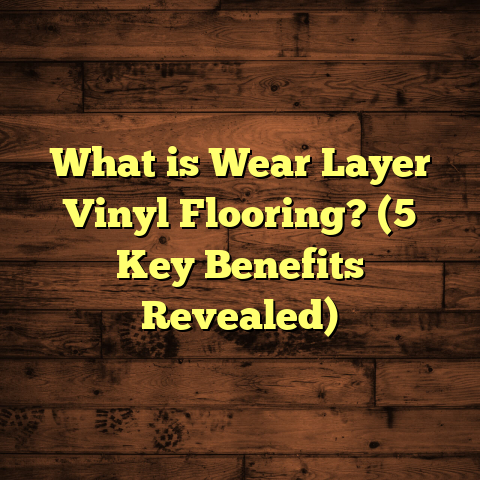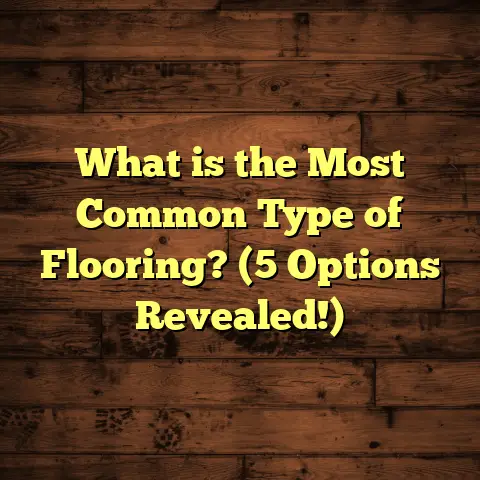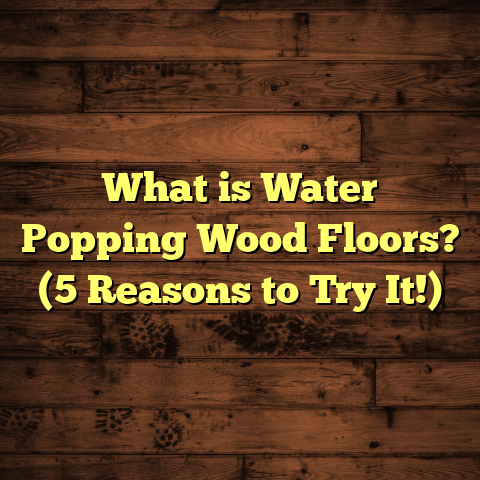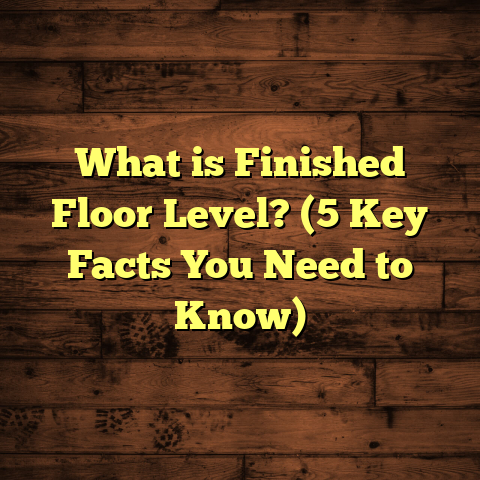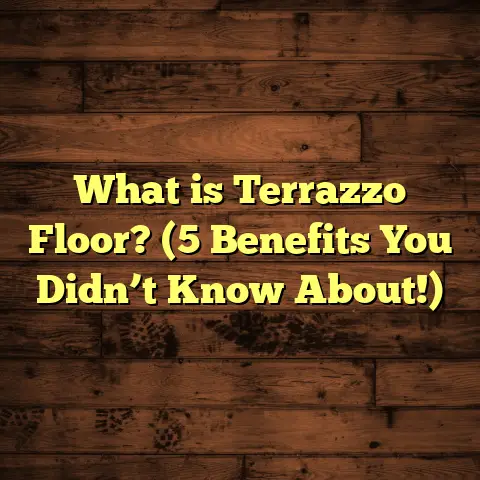What is Faux Wood Flooring? (5 Benefits You Need to Know)
When I think about luxury in a home, one of the first things that comes to mind is flooring. There’s something about wood floors—whether it’s the rich color, the natural grain, or the way they feel underfoot—that instantly makes a space feel warm, inviting, and elegant. I’ve spent years installing floors and watching how the right flooring can transform a room. But here’s the thing: not everyone can afford real hardwood or wants to deal with its upkeep. That’s why I’ve grown such an appreciation for faux wood flooring. It’s like having the luxury of hardwood without many of the headaches.
Let me share what I’ve learned about faux wood flooring, its benefits, and why it might be the perfect choice for your home. Over the years, I’ve seen it evolve from a budget-friendly alternative to a top contender for style and durability. Whether you’re remodeling your kitchen, updating your basement, or just want a fresh look, faux wood flooring deserves a closer look.
What Is Faux Wood Flooring?
You might be wondering exactly what faux wood flooring is. The term “faux” means fake or imitation, so faux wood flooring refers to materials designed to look like real wood but aren’t actually made from solid wood.
There are several types of faux wood flooring, but the most common ones include:
- Laminate Flooring: Made by fusing fiberboard with a photographic layer that mimics wood grain and color, topped with a durable clear wear layer.
- Luxury Vinyl Plank (LVP): Vinyl flooring shaped into planks with printed wood patterns and textures, often waterproof.
- Engineered Wood: Though technically real wood on the surface, engineered wood has multiple layers underneath, making it more stable and less sensitive to moisture compared to solid hardwood.
In my experience, when most people say faux wood flooring, they’re usually referring to laminate or vinyl options because these are fully synthetic and offer many advantages over real wood in terms of cost and maintenance.
Why Does Faux Wood Flooring Look So Real?
Advances in manufacturing technology have transformed faux wood floors into remarkably realistic surfaces. High-resolution photographic technology can capture wood grain patterns down to the smallest detail. On top of that, embossing techniques add texture that feels like real wood when you run your hand over the floor.
I remember working on a project where a client was skeptical about vinyl plank flooring. They insisted it would look cheap and plastic-like. After installation, even their friends couldn’t tell it wasn’t real hardwood. That moment really showed me how far these products have come.
Different Styles and Finishes
Faux wood flooring isn’t just one look—it comes in a variety of styles to fit different design tastes:
- Rustic barnwood with knots and distress marks
- Sleek modern planks with smooth finishes
- Classic oak or maple for a timeless feel
- Exotic wood patterns like herringbone or chevron
This diversity lets homeowners customize their floors to match their personal style without the limitations or cost of sourcing rare woods.
1. Cost-Effectiveness Without Sacrificing Style
Let’s talk money—because who doesn’t want luxury without spending a fortune?
Real hardwood floors are beautiful but expensive. The materials alone typically cost between $8 and $15 per square foot. Installation fees add on top of that, sometimes doubling the total cost. Plus, if you include maintenance like refinishing every few years, the long-term cost climbs even higher.
Faux wood flooring flips that equation. On average, laminate and luxury vinyl plank floors range between $2 and $6 per square foot including installation. That’s a huge difference when you consider a 1,000-square-foot living room.
My Experience With Budget-Conscious Clients
A couple I worked with recently wanted hardwood floors but were renovating on a tight budget. We explored several options and settled on laminate flooring at around $3.50 per square foot. The end result? They got the warm oak look they desired at less than half the price of solid hardwood.
They were thrilled—especially since they were able to allocate saved funds toward other parts of their renovation like lighting and furniture.
Breaking Down the Costs
To give you a clearer picture:
| Flooring Type | Material Cost per Sq Ft | Installation Cost per Sq Ft | Total Estimated Cost per Sq Ft |
|---|---|---|---|
| Solid Hardwood | $8 – $15 | $4 – $8 | $12 – $23 |
| Engineered Wood | $5 – $10 | $3 – $6 | $8 – $16 |
| Laminate Flooring | $1.50 – $4 | $2 – $4 | $3.50 – $8 |
| Luxury Vinyl Plank | $2 – $5 | $2 – $5 | $4 – $10 |
These numbers are averages and depend on your location and specific materials chosen, but they give you an idea of how faux wood flooring fits into different budgets.
2. Durability That Handles Real Life
One thing I always highlight to homeowners is durability because floors have to stand up to daily life—kids running around, pets scratching, furniture being moved.
Real hardwood is beautiful but softer woods can dent or scratch easily. Even harder woods like oak or maple aren’t immune to wear.
Laminate and vinyl floors are designed with durability in mind:
- Laminate has a tough wear layer that resists scratches and stains.
- Vinyl planks are extremely resilient against dents and scuffs.
- Many faux wood floors are also UV resistant so they won’t fade quickly in sunlight.
Data That Speaks Volumes
According to research from the National Wood Flooring Association (NWFA), laminate floors resist impacts approximately 30% better than traditional hardwood in typical residential use.
Luxury vinyl has shown even higher resistance to scratches and stains because of its plastic composition.
Real Stories from My Installations
I recall installing vinyl plank flooring for a family with two energetic dogs that scratched up previous hardwood floors badly. After switching to vinyl, their new floor looked great after years of paw traffic and muddy paws coming inside from rain.
Another client with kids loved how their laminate floor stayed looking brand new even after toys were dropped or moved around repeatedly.
3. Low Maintenance Keeps Your Life Simple
Let’s be honest—who has time for complicated cleaning routines? Hardwood floors require special care: gentle cleaners, avoiding excess water, refinishing every few years to keep them looking fresh.
Faux wood floors make maintenance much easier:
- Sweep or vacuum regularly to remove dirt.
- Mop occasionally with mild cleaners.
- No need for sanding or refinishing.
- Stain-resistant surfaces simplify cleanups.
One homeowner told me she was amazed how her vinyl plank floor stayed spotless after two years of busy family life with minimal effort.
Comparison: Cleaning Hardwood vs Faux Wood
| Task | Hardwood Flooring | Faux Wood Flooring |
|---|---|---|
| Sweeping | Yes | Yes |
| Mopping | Yes (with special care) | Yes (simple cleaners) |
| Refinishing | Every 5-10 years | Not needed |
| Stain Resistance | Moderate | High |
| Moisture Sensitivity | High | Low / Waterproof |
The convenience factor alone is a major reason many people choose faux wood for kitchens or basements where spills happen frequently.
4. Water Resistance Opens Up New Spaces
I can’t stress this enough: water is hardwood’s enemy. Even minor spills can cause warping or staining if not cleaned immediately. This vulnerability limits hardwood’s use in places like kitchens, bathrooms, laundry rooms, or basements.
Faux wood flooring solves this problem in many cases:
- Luxury vinyl planks often feature waterproof cores.
- Laminate with special coatings offers water-resistant options.
- Engineered hardwood is more stable but still less water-resistant than vinyl.
Case Study: Basement Renovation Saved by Vinyl Planks
I worked on a basement remodel where moisture was a big concern due to previous flooding issues. The client loved the look of wood but knew solid hardwood was out of the question.
We chose waterproof luxury vinyl planks that could handle occasional dampness without damage. Several years later, the floor looks flawless despite occasional spills or humidity fluctuations—a win-win scenario.
How Water Resistance Affects Installation Choices
If you want wood-look floors in wet areas, ask manufacturers about water resistance ratings or warranties related to moisture damage. This can save you from costly mistakes down the road.
5. Eco-Friendly Options Are Expanding
Environmental impact matters now more than ever—and that includes the materials we put in our homes.
Some people assume all synthetic floors are bad for the environment but that’s not always true anymore. Manufacturers have made strides toward sustainability:
- Using recycled content in vinyl and laminate cores.
- Employing low-VOC adhesives and finishes for healthier indoor air.
- Designing floors for longevity which reduces waste over time.
My Research Into Sustainable Faux Wood Flooring
I dug into recent studies and found some luxury vinyl flooring brands now contain up to 50% recycled materials without sacrificing quality or appearance.
Furthermore, third-party certifications like FloorScore or GREENGUARD confirm many products meet strict indoor air quality standards.
For homeowners wanting green options with style and durability, these developments make faux wood floors an excellent choice.
What About Installation? Can You DIY Faux Wood Flooring?
One of the perks I often share with clients is that many faux wood floors are designed for easy installation—even by non-professionals.
Click-lock or tongue-and-groove systems let you float floors over existing surfaces without glue or nails. This can save money and time if you’re comfortable with DIY projects.
Tips From My Experience
- Always prep subfloor properly—clean and level.
- Measure carefully and order extra material (usually 5-10%) for cuts and mistakes.
- Use spacers for expansion gaps around edges.
- Watch online tutorials if you’re new to flooring installation.
While some complex layouts or uneven surfaces may require pros, many homeowners successfully install laminate or vinyl planks themselves.
Comparing Faux Wood Flooring Types: Which One Fits You Best?
Let me break down the main types I work with so you can see which might suit your needs:
Laminate Flooring
- Material: Composite fiberboard with photographic wood layer
- Pros: Affordable, scratch resistant, easy install
- Cons: Less water resistant (some newer options improve this)
- Best For: Living rooms, bedrooms, low moisture areas
Luxury Vinyl Plank (LVP)
- Material: PVC vinyl shaped into planks
- Pros: Waterproof options, highly durable, soft underfoot
- Cons: Some cheaper versions can look less realistic
- Best For: Kitchens, basements, high moisture areas
Engineered Hardwood
- Material: Real wood veneer over plywood layers
- Pros: Real wood surface, more stable than solid hardwood
- Cons: More expensive than laminate/vinyl; less water resistant
- Best For: Areas where real wood look is desired but better stability needed
How Faux Wood Flooring Holds Up Over Time
One question I get asked a lot is about longevity. Can faux wood flooring last as long as hardwood?
The answer depends on quality and care:
- High-quality laminate and vinyl floors can last 10–20 years with proper maintenance.
- Engineered hardwood can last 20+ years but may need refinishing depending on veneer thickness.
- Solid hardwood often lasts decades but requires more upkeep.
From what I’ve seen firsthand, many homeowners happily replace faux wood every 15 years while enjoying lower upfront costs and easier maintenance during those years.
What About Environmental Impact Compared to Hardwood?
Here’s something interesting: while hardwood is natural and renewable, its production involves cutting down trees which impacts forests unless sustainably sourced.
On the other hand:
- Faux wood uses synthetic materials but increasingly incorporates recycled content.
- Long-lasting synthetic floors reduce waste from frequent replacements.
- Low-VOC products contribute to healthier indoor air quality.
If sustainability matters to you, look for certifications like FSC (for hardwood) or FloorScore/GREENGUARD (for synthetic products) when choosing materials.
My Personal Anecdote: How Faux Wood Saved My Client’s Sanity
One client story sticks with me—an elderly couple downsizing from their family home worried about slippery tile in their kitchen. They wanted warmth underfoot but feared hardwood was too high maintenance at their age.
We installed luxury vinyl plank flooring that mimicked cherry wood perfectly. The floor was soft enough underfoot yet slip-resistant—a combination they loved instantly.
Six months later they told me their new floor “made cooking enjoyable again.” Hearing that made all the difference because it wasn’t just about aesthetics—it improved their daily life.
Frequently Asked Questions I Hear From Clients
Q: Does faux wood flooring feel cold compared to real hardwood?
A: It depends on material; vinyl tends to feel softer and warmer underfoot compared to tile but not as naturally warm as solid wood. Area rugs help add warmth anywhere you want it.
Q: Can I install faux wood over concrete?
A: Yes! Many types of laminate and vinyl are great for concrete subfloors as long as moisture levels are controlled properly before installation.
Q: Is faux wood good for radiant heating?
A: Certain laminate and vinyl products are compatible with radiant heating systems—always check manufacturer specs first before installation.
Q: How do scratches on faux wood compare to real hardwood?
A: High-quality laminates resist scratches better than many hardwoods; vinyl also resists dents well. You can replace individual planks if damage happens without huge expense.
Wrapping Up My Thoughts
I’ve installed all kinds of floors over my career—from traditional hardwoods to quirky tiles—but faux wood flooring keeps standing out as an excellent solution for many homeowners who want style without compromise.
It fits budgets better
It handles real life better
It makes cleaning easier
It survives moisture better
And it’s becoming more eco-friendly
If you’re considering new flooring, don’t overlook faux wood options. They might surprise you with how close they come to the real thing—sometimes even stealing the show altogether!
Have you had any experience with faux wood flooring? I’d love to hear what worked well for you or what questions you have before choosing your next floor!
If you want help figuring out costs tailored to your area or design preferences, tools like FloorTally provide detailed estimates based on local labor rates and materials—which makes planning smoother.
Thanks for hanging out while I shared my thoughts on this topic! Here’s hoping your next floor upgrade brings both beauty and ease into your home for years to come.

